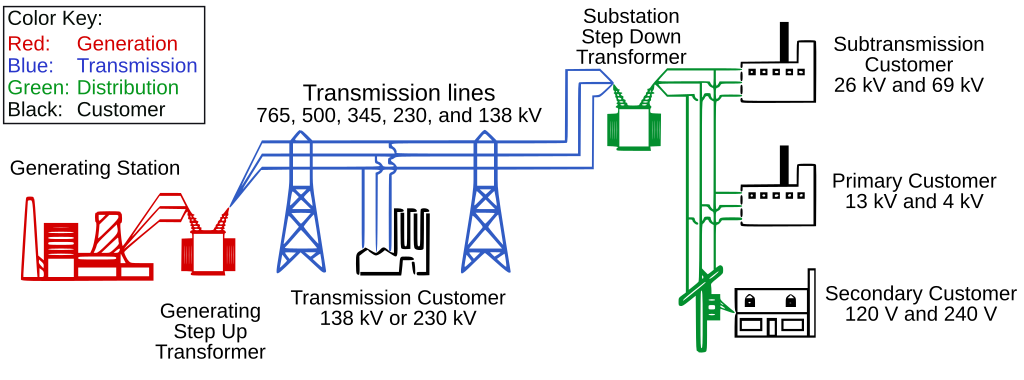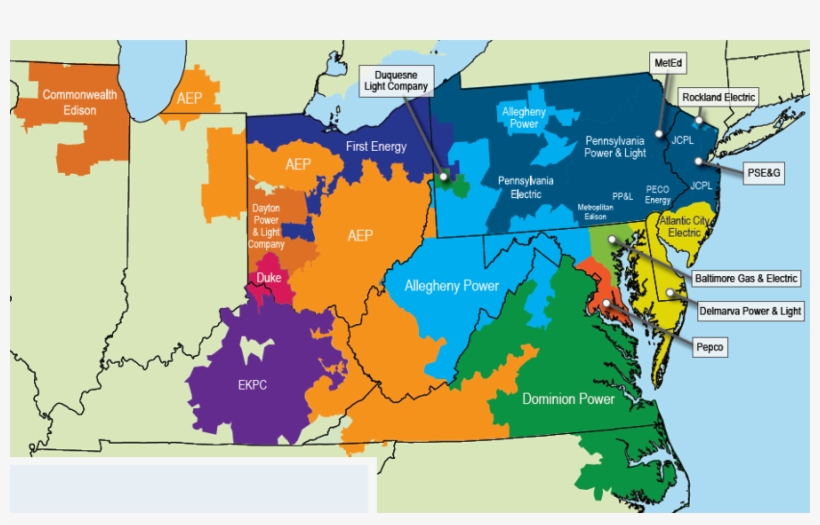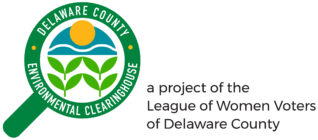The Electric Power Grid

Every path to carbon reduction eventually leads to the electric power grid, the center of our energy system. But what, exactly, is the power grid, and why is it essential? It’s something few of us think about, but all of us depend on.
Mention the words “the grid” to most people, and they will immediately think of mile after mile of huge towers strung with wires. And that’s not wrong, but it’s not the whole story. There are actually four parts to the U.S. electrical system, all of which must be coordinated in order to keep the lights on.

In the diagram above, the generating stations are in red, whether powered by coal, gas, nuclear, or other energy source. Their output is boosted to very high voltage in order to facilitate transmission over long distances, by way of those familiar towers.
Some of that high voltage is taken off directly to power very large industrial customers, or big data centers. Most, however, is sent on to regional and local substations, where it is distributed at lower (but still dangerous) high voltages to smaller industrial and commercial users and to neighborhood homes and businesses.
So far, so good. Power is generated and sent over the wires to customers, who use it for whatever they need. But, unfortunately, things get more complicated. The amount of power generated at any given moment has to match up with the amount that customers want to use (“demand”) at that time. Too much generation causes voltages to rise, making equipment overheat and fail. Too little, and the voltage will drop, causing motors to work harder and shortening their life.
On top of that, the alternating current coming from the various generators has to be synchronized among them, so that they are “in phase”, i.e., so that the peaks and valleys of their individual sine waves match up. Lack of synchronization causes serious losses across the grid, and if not properly contained can cause widespread failures. And the frequency needs to be maintained at a precise 60 ticks per second, 3600 per minute, exactly 216,000 every hour, the heartbeat of our society. It keeps clocks accurate and provides basic timing for much of the infrastructure of modern life.
Managing all of this is handled by the Regional Transmission Operator (RTO), a multi-state organization which is tasked by the Federal government with this responsibility. (In states which operate their own grids, a similar entity is the Independent System Operator, or ISO.) In Pennsylvania, we are part of the PJM Interconnect, which serves parts of 13 states in the mid-Atlantic region.

All of this requires a huge investment in equipment and maintenance. And the writing on the wall says that the future will be electric, so further build-outs will be necessary. To that end, the Inflation Reduction Act, passed in 2022, includes substantial funding to support that work.
Baseload, Intermittents, and Peakers
Different kinds of generators have different characteristics which determine when and how they are used on the grid. Coal and nuclear plants, for example, take a long time to ramp up or down, and thus are useless for responding to rapid changes in demand. For this reason, they are often referred to as “baseload” generators, producing a constant amount of power to support usage that doesn’t vary much from day to day or hour to hour.
Intermitttent power sources are those such as solar and wind, which do not operate continuously and whose output may vary at any time. Wind power is generally stronger at night, while solar of course follows a predictable hourly variation, but both are affected by weather. For this reason, intermittent sources need to be balanced out with other sources which can be easily dialed up and down.
Most commonly, these are gas “peaker” plants, so called because they are there to manage peak loads. With the decline in coal generation and the increase in wind and solar, many new gas peaker plants have been built in recent years, spurred on by the abundance of natural gas due to fracking. This is a matter of concern because, while the gas plants emit less carbon than the coal plants they replace, they also represent a long-term commitment to fossil fuels, which can limit future progress.
A growing option is the use of batteries to store excess solar and wind energy, and to release it as needed. While batteries have some limitations, including the length of time they can operate, they have many advantages: they can be quickly installed and deployed, with minimal permitting required if appropriately located; and they can dispatch power instantaneously to respond to disturbances on the grid.
There’s also something called a “virtual power plant”, which is actually just another form of a battery system. The unusual thing about a virtual power plant is that the batteries are owned not by a utility, not by a cooperative, not by a non-profit, but by individual homeowners who have installed battery backup systems in their homes, usually along with solar. In a virtual power plant, those battery systems are tied together by a software app, putting power back on the grid at times of high demand, for which owners are paid.
Microgrids
According to Wikipedia, a microgrid is a “local electrical grid with defined electrical boundaries, acting as a single and controllable entity.” To put that in English, just think of a home with a backup battery or generator. When the power goes out, it disconnects from the grid and supplies the house on its own, within its limits.
On a larger scale, it’s convenient to think of it in terms of a neighborhood that’s all connected to a single substation, i.e. all the homes that lose power when it goes out. Add to that some sophisticated controls and switches that can manage all those home backup systems as a group. Ordinarily, it draws power from the grid as needed just as a conventional substation does. In an emergency, however, the system can disconnect from the regional grid and deploy its own resources to supply backup power to the entire neighborhood.
It’s not quite as simple as it sounds, though, and microgrids are still considered an emerging technology. In an era where resiliency is paramount, however, they offer great promise for the future. And for isolated communities, a microgrid may be the only practical way to obtain electric power.
— David Director, Clearinghouse Team
Further Reading
Note: Some materials may contain work provided or sponsored by industry. While that fact does not invalidate their content, and indeed industry experts can be the most knowledgable, readers should be cognizant of the potential for bias in such materials, particularly concerning policy matters.
- Pennsylvania Tentative PUC Order re rates and availablity of electricity from the power grid for large data centers 11-06-2025
- Study: PA one of only 11 states to disclose public subsidies for data centers, but information is sparse — Goo Jobs First.Org
- The Electric Grid — MIT Climate Portal
- The Grid: Electricity Transmission, Industry, and Markets — Stanford Energy
- Grid Modernization and the Smart Grid — US Dept of Energy
- Building a sustainable grid for a brighter energy future — Canary Media / Hitachi Energy — 09-21-24
- Virtual Power Plants Can Help the Electric Grid — Here’s How — Canary Media
- As demand for AI grows, so does data center drain on power grid — PA Capital-Star 04-21-25
